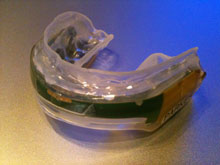Mouthpieces Gather Impact Data from Football Players
Despite growing concern over the long-term consequences of head injuries in contact sports, researchers still aren’t sure how different types of blows affect the brain.

Now a team at Stanford University is employing sensor-laden mouth guards to gauge the effects of head injuries in football players. The researchers plan to expand their research to other sports, including women’s lacrosse and hockey. They are hoping that the mouth guards, created by Seattle-based X2 Impact, will be an affordable alternative to specialized helmets that have been used in head injury studies.
Over the past several years, researchers have used helmets embedded with sensors to record the hits and impact forces sustained by athletes. But they still don’t know which types of hits are most likely to cause concussions, and whether there is a threshold of hits past which serious damage may occur.
Dan Garza, assistant professor of orthopaedic surgery at the Stanford School of Medicine, and his team recently completed a study of the mouth guards using crash-test dummies, and plan to publish the data soon. In the meantime, they are testing the mouth guards in college football players this season, and will also use them in women’s lacrosse and field hockey.
Garza believes that the mouth guards may turn out to be more accurate than helmets because they don’t shift as much during impact. They also read forces inside the skull more closely, and they’re cheaper. “It will be interesting to see how the data compares” to previous data with helmets, he says. The Stanford studies will collect data from the mouthpieces as well as video of plays, when available, and clinical information about players’ injuries.
Christophe Mack, cofounder of X2 Impact, agrees that the mouth guards will be better than helmets at capturing the impact forces inside the head. The devices have six sensors measuring linear and rotational forces. They transmit information wirelessly to a monitoring device on the sidelines. A proprietary algorithm estimates the forces felt by the brain based on what the mouthpiece records. Mack says the mouthpieces don’t shift around excessively during play because they are molded to a player’s mouth. When they do shift, the system recognizes this and corrects for the movements. The mouthpieces also contain sensors that indicate whether they are in contact with mouth tissue. The company is partnering with Bite Tech to make the mouth guards commercially available next year.
Robert Cantu, who codirects the Center for the Study of Traumatic Encephalopathy at Boston University, says that all impact-sensing technologies have problems explaining the effects that various kinds of impact have on the brain, and no device can accurately predict a concussion. He’s also skeptical whether a mouthpiece could record forces accurately, because “the majority of hits to athletes are not to where the mouth guard is.” However, he thinks impact-sensing technologies can contribute a great deal of knowledge simply by noting when a blow happens, even if they can’t determine the exact location and force. “It’s hugely important to record the number of hits,” he says.
Research using impact-sensing helmets developed by Simbex has already prompted Ivy League schools to change practice guidelines to reduce the number of hits players sustain. Jonathan Beckwith, director of research at Simbex, explains that finding a relationship between impacts and injury has been difficult without recording enough injuries to draw meaningful conclusions, but the company and partnering researchers “have now recorded more than 100 diagnosed injuries on the field,” and will publish findings from those studies soon.
Keep Reading
Most Popular
Large language models can do jaw-dropping things. But nobody knows exactly why.
And that's a problem. Figuring it out is one of the biggest scientific puzzles of our time and a crucial step towards controlling more powerful future models.
How scientists traced a mysterious covid case back to six toilets
When wastewater surveillance turns into a hunt for a single infected individual, the ethics get tricky.
The problem with plug-in hybrids? Their drivers.
Plug-in hybrids are often sold as a transition to EVs, but new data from Europe shows we’re still underestimating the emissions they produce.
Stay connected
Get the latest updates from
MIT Technology Review
Discover special offers, top stories, upcoming events, and more.